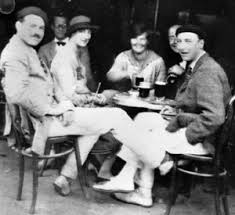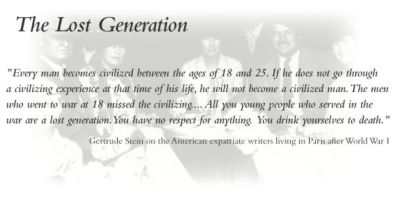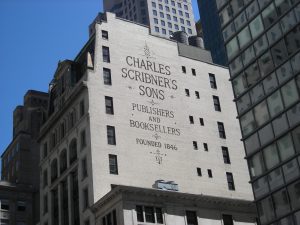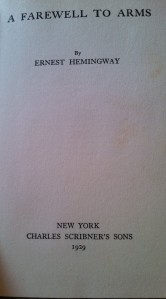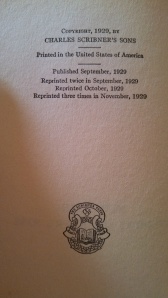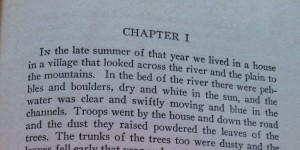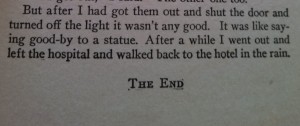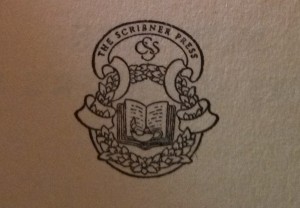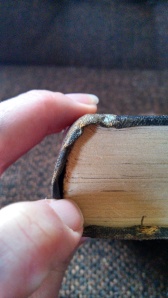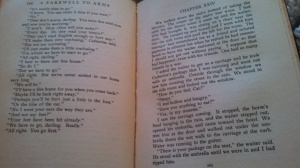Ernest Miller Hemingway was born in Oak Park Illinois on July 21, 1899. His father Clarence was a doctor and his mother Grace was a music teacher. They followed the Congregational Church and were deeply religious. Hemingway’s father Clarence was an avid outdoors man. He instilled a love of nature in young Ernest. Clarence also gave medical care to those who could not afford it. Due to damage in her eyes from Scarlet Fever, Grace Hemingway had given up her childhood ambition of being an opera singer. Instead, she taught music and voice lessons. Rather striking for the time, Grace often earned more money than Clarence did and refused to cook or do housework. Ernest’s sister Marcelline was 18 months his elder. This did not stop their mother from dressing the two alike and passing them off as twins. Marcelline was even held back in school so that the two could enter first grade together. Sometimes Grace dressed them both as boys, sometimes as girls (Bloom, 2002).
The summer after Ernest graduated from high school he moved to Kansas City and became a reporter for the Star. Due to the shortage of men caused by World War I, Ernest was hired, despite being only 17, for fifteen dollars a day (Bloom). It was at the Star that Hemingway learned, “the best rules I ever learned for the business of writing. I’ve never forgotten them.” (Bloom, 2002, p. 16). The rules that Hemingway learned became part of his iconic writing style. The assistant editor, C.G. Wellington gave Hemingway the Star style sheet with 110 items including, “Use short sentences. Use short first paragraphs. Use vigorous English, not forgetting to strive for smoothness” (Bloom, 2002, p. 16).
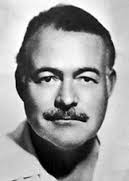
In 1918, when he became 18, Hemingway volunteered to be an ambulance driver for the Red Cross. After a short time in Italy, Hemingway felt that he needed more action than being an ambulance driver afforded him. So he volunteered for canteen duty. In canteen duty, volunteers waited behind the trenches with cigarettes, coffee, soup and candy. These were given to soldiers on their breaks. Hemingway would then ride his bike with supplies to the trenches, sometimes staying and chatting with the Italian soldiers. On July 8th, he was in a trench when a mortar exploded. Hemingway was wounded in the legs. Despite his injury, he carried another wounded soldier on his back to the first aid station, 150 yards away. While running, Hemingway was shot in the legs by an Austrian shooter, but continued running carrying the soldier (Bloom, 2002). In the hospital, 28 fragments were removed from his legs. Hemingway was transferred to the Red Cross hospital in Milan. It was here that he met a nurse named Agnes von Kurowsky. He fell in love with Agnes, expecting to marry her when the war was over. However, after he returned to the US, Agnes sent him a letter in which, she told him that she was marrying someone else (Bloom, 2002). The details of Hemingway’s injury have been contested multiple times and the story changes depending upon which source is referred to. Bloom’s version is the one I have chosen to follow because it was the story that Hemingway touted. It has been suggested that he did not save another man’s life, nor did he run nearly as far as claimed, but those are details in which the truth has been lost to history (Bloom, 2002).
In 1921, Hemingway married Hadley Richardson. The two of them moved to Paris and had a son, Jack in 1922 (Palin). During this time, Hemingway became a part of the Lost Generation, a group of ex-patriot writers and artists living in Post-War Paris. Hemingway wrote several short stories and two novels while living with Hadley in Paris. In 1926, the couple befriended Pauline Pfeiffer. Hemingway, in love with both women, was forced to choose between the two. He divorced Hadley and moved back the United States with Pauline (Crisman, 1998).
Hemingway began writing A Farewell to Arms in 1928. By this time he was married to his second wife Pauline. They had just moved from Paris to the Florida Keys, where, “men were adventurers, not artists” (Crisman, 1998). Hemingway loved sportsmanship. He loved to fish, hunt and box, earning himself the epitaph as an “Icon of super-masculinity” (Crisman, 1998).
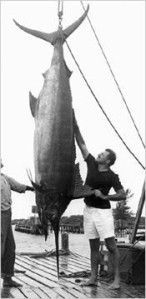
It was in the Keys that he developed his love for marlin fishing. He was so good at sport fishing that he won several contests, to the consternation of the locals. He challenged any man who wanted his trophy to three rounds in the boxing ring, he won every fight. During this time period, prohibition was also in full effect and Hemingway became a bootlegger. He and his friends would travel to Cuba and bring rum and absinthe back to Sloppy Joe’s bar in the Keys (Crisman, 1998).
Despite his crazy adventures, Hemingway took his writing very seriously. He would wake up at 5 am and write until early afternoon. It was in this fashion that he wrote A Farewell to Arms, which was published as a serial in Scribner’s Magazine in the spring of 1929 (Crisman, 1998). While Ernest was writing A Farewell to Arms, Clarence Hemingway-sick with diabetes-shot himself in his Oak Park home (Bloom, 2002). Hemingway wrote to Pauline’s mother saying, “I’ll probably go the same way” (Crisman, 1998). Several years later, in 1961, at his home in Ketchum Idaho, Hemingway shot and killed himself. By that time he had published seven novels, six short stories and two works of nonfiction. In 1954, he won the Nobel Prize in Literature for The Old Man and the Sea. Several more books were published posthumously (Nobel, 2013).



